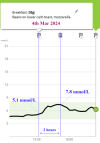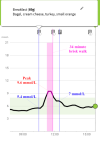SillySallySo
Member
- Relationship to Diabetes
- Type 2
Could someone please clarify when I'm supposed to test after a meal?
It says to test 2hrs after a meal but do I start the 2hr countdown from the moment I start eating or when I've finished eating?
Thank you.
It says to test 2hrs after a meal but do I start the 2hr countdown from the moment I start eating or when I've finished eating?
Thank you.



